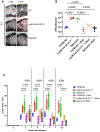Glucose transporter 1 is essential for the resolution of methicillin-resistant S. aureus skin and soft tissue infections
- PMID: 38990718
- PMCID: PMC11323221
- DOI: 10.1016/j.celrep.2024.114486
Glucose transporter 1 is essential for the resolution of methicillin-resistant S. aureus skin and soft tissue infections
Abstract
Skin/soft tissue infections (SSTIs) caused by methicillin-resistant Staphylococcus aureus (MRSA) pose a major healthcare burden. Distinct inflammatory and resolution phases comprise the host immune response to SSTIs. Resolution is a myeloid PPARγ-dependent anti-inflammatory phase that is essential for the clearance of MRSA. However, the signals activating PPARγ to induce resolution remain unknown. Here, we demonstrate that myeloid glucose transporter 1 (GLUT-1) is essential for the onset of resolution. MRSA-challenged macrophages are unsuccessful in generating an oxidative burst or immune radicals in the absence of GLUT-1 due to a reduction in the cellular NADPH pool. This translates in vivo as a significant reduction in lipid peroxidation products required for the activation of PPARγ in MRSA-infected mice lacking myeloid GLUT-1. Chemical induction of PPARγ during infection circumvents this GLUT-1 requirement and improves resolution. Thus, GLUT-1-dependent oxidative burst is essential for the activation of PPARγ and subsequent resolution of SSTIs.
Keywords: CP: Metabolism; CP: Microbiology; aureus; immunometabolism.
Copyright © 2024 The Author(s). Published by Elsevier Inc. All rights reserved.
Conflict of interest statement
Declaration of interests The authors declare no competing interests.
Figures







Similar articles
-
Peroxisome Proliferator-Activated Receptor γ Is Essential for the Resolution of Staphylococcus aureus Skin Infections.Cell Host Microbe. 2018 Aug 8;24(2):261-270.e4. doi: 10.1016/j.chom.2018.07.001. Epub 2018 Jul 26. Cell Host Microbe. 2018. PMID: 30057172
-
Characterization of methicillin-resistant Staphylococcus aureus from skin and soft tissue infections in patients in Nairobi, Kenya.Int J Infect Dis. 2013 Feb;17(2):e115-9. doi: 10.1016/j.ijid.2012.09.006. Epub 2012 Oct 23. Int J Infect Dis. 2013. PMID: 23092752
-
Changes in prescriptive practices in skin and soft tissue infections associated with the increased occurrence of community acquired methicillin resistant Staphylococcus aureus.J Infect Public Health. 2013 Dec;6(6):423-30. doi: 10.1016/j.jiph.2013.04.010. Epub 2013 Jun 15. J Infect Public Health. 2013. PMID: 23999333
-
New drugs for methicillin-resistant Staphylococcus aureus skin and soft tissue infections.Curr Opin Infect Dis. 2022 Apr 1;35(2):112-119. doi: 10.1097/QCO.0000000000000800. Curr Opin Infect Dis. 2022. PMID: 34812745 Review.
-
Emerging drugs for complicated skin and skin-structure infections.Expert Opin Emerg Drugs. 2010 Sep;15(3):509-20. doi: 10.1517/14728214.2010.497486. Expert Opin Emerg Drugs. 2010. PMID: 20557269 Review.
References
-
- Talan DA, Krishnadasan A, Gorwitz RJ, Fosheim GE, Limbago B, Albrecht V, and Moran GJ; for The EIDNSG (2011). Comparison of Staphylococcus aureus From Skin and Soft-Tissue Infections in US Emergency Department Patients, 2004 and 2008. Clin. Infect. Dis. 53, 144–149. - PubMed
-
- Pillai SK, Sakoulas G, Wennersten C, Eliopoulos GM, Moellering RC Jr., Ferraro MJ, and Gold HS (2002). Linezolid Resistance in Staphylococcus aureus: Characterization and Stability of Resistant Phenotype. J. Infect. Dis. 186, 1603–1607. - PubMed
Publication types
MeSH terms
Substances
Grants and funding
LinkOut - more resources
Full Text Sources
Medical
Miscellaneous

